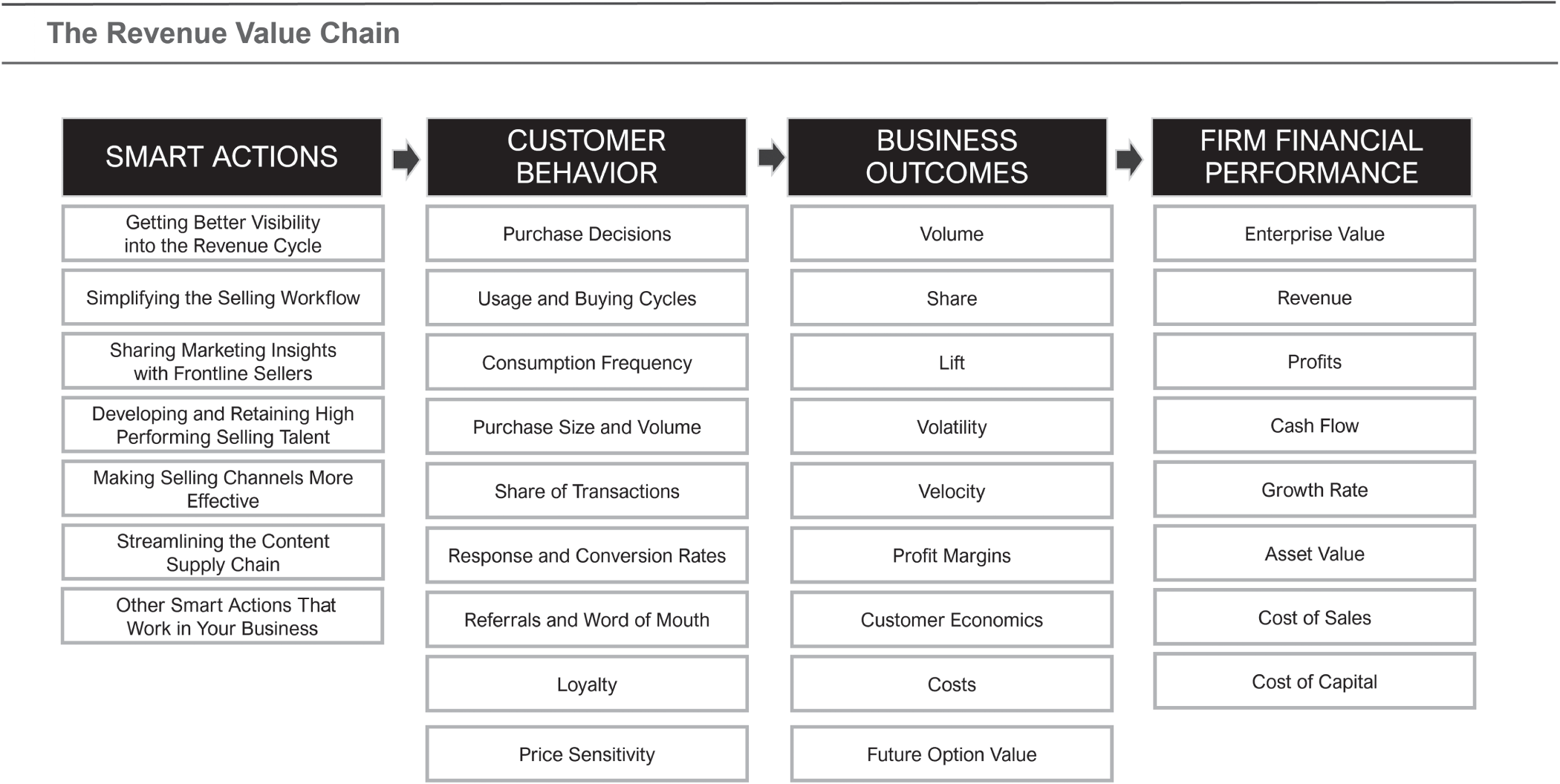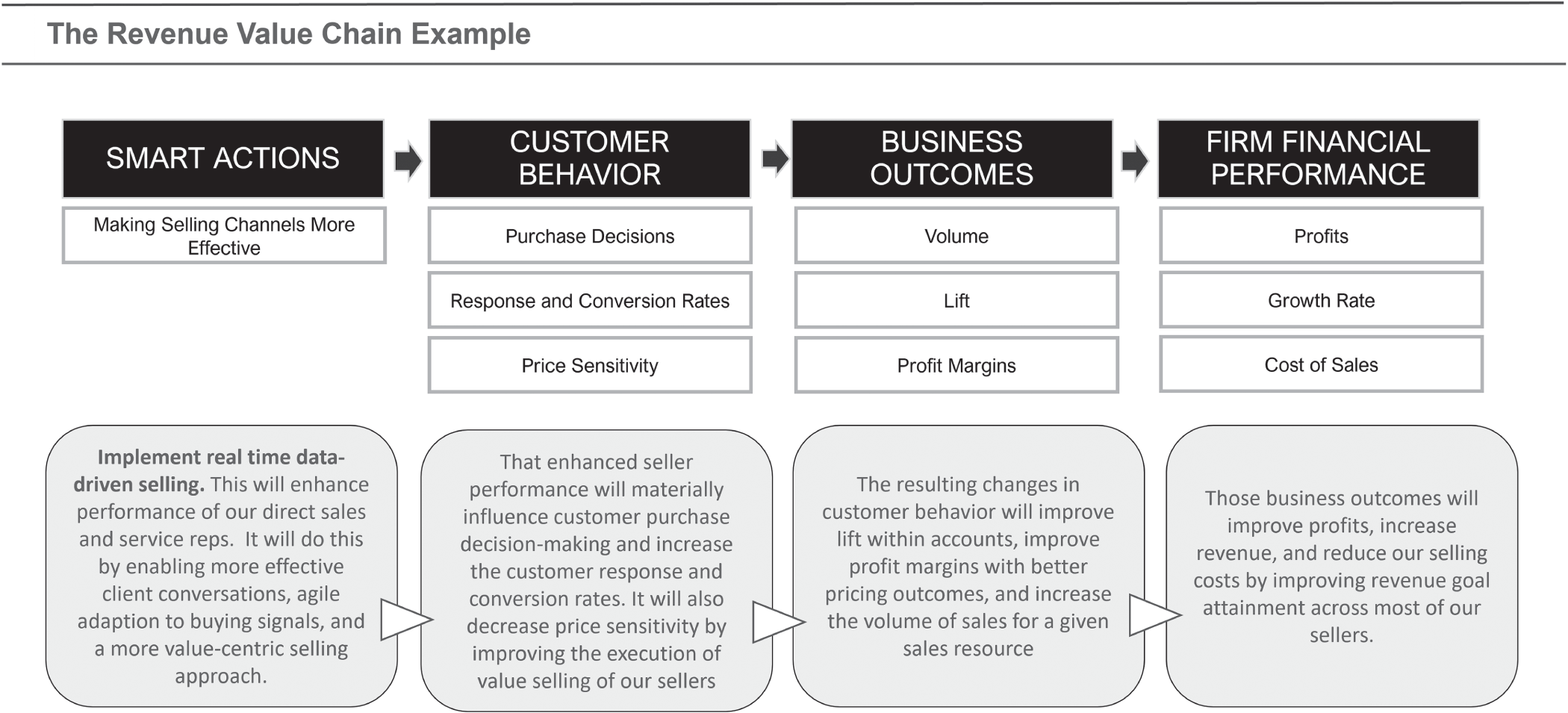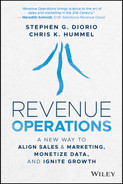CHAPTER 13
Make the Business Case for Your Growth System, from Activity to Impact
Prioritize Actions That Will Generate Short- and Long-Term Value
The Smart Actions outlined in chapter 11 create short- and long-term value. They generate short-term financial gains by reducing leakage, improving sales performance, and eliminating waste, while also stacking to generate higher, longer-term returns on your technology, data, and selling infrastructure assets. Smart Actions also create longer-term value by building out an operating system for scalable and sustainable growth at lower cost. These activities are strategic growth investments that change customer behavior in ways that generate future revenues, cash flow, pricing power, and profits.
The challenge comes in proving impact to justify funding and investment. You must overcome a few common obstacles, if you want to build a financial case for taking Smart Actions to connect the dots across your growth technology ecosystem.
First, remember that Smart Actions span functions. Finding a single established budget and owner for cross-functional initiatives is a challenge. Teamwork, sharing, and coordination must exist to gain funding, or the initiative will fall back into organizational, technology, and data silos. Often it's easier to purchase senseless or illogical solutions that fit within an existing budget than to acquire a smart, cost-effective solution that spans many budgets.
Second, conventional measures of sales and marketing effectiveness, such as revenue attribution and sales waterfall metrics, have fundamental flaws and fail to clearly describe how a business grows. They may help optimize media, campaigns, and tactics but do little to justify strategic capital investments. Such measures have reputations as “black boxes” where the connections between activities are poorly understood. Too many gaps still exist along the chain of custody between activity and financial impact.
Take, for example, the classic demand funnel. Sales enablement professionals often rely on linear sales waterfall models with flawed assumptions about how customers buy and how a modern operating system operates. The notion of a lead being generated by marketing and then transferred to a seller contradicts the required alignment of revenue teams around the customer and sabotages a seamless customer experience.
More fundamentally, these measurement models tend to ignore key drivers of value growth in a business. These drivers include things like building customer equity, improving channel effectiveness, and sharing information on financial performance and firm value across the revenue team, according to Professor Dominique Hanssens, Distinguished Research Professor of Marketing at the UCLA Anderson School of Business whose research focuses on short-and long-run impact of marketing on business performance. For example, while building customer equity, improving digital channel effectiveness, and sharing information across revenue teams have all been proven to be causal of firm value, according to academic research, few business leaders really understand how.
Third, Smart Actions involve a mix of operating expenses and capital expenditures. This makes funding difficult because few managers and finance executives have a good understanding of the financial relationship between growth CapEx, firm value, and financial performance. The growing role of data, analytics, CRM, content, sales enablement, and digital marketing channels within the Revenue Operations model puts more pressure on something managers already struggle with: balancing long-term strategic investments with short-term performance tactics. A modern selling system needs funding for a multiyear technology and digital channel road map to support scalable and sustainable growth. Unfortunately, funding review processes favor short-term initiatives and programs that pay off quickly. You will need a very credible financial rationale for the changes you intend to make.
For example, look at the visibility Smart Action outlined in chapter 11. Quantitative analysis of the performance of 300 marketing organizations by Forbes and the Marketing Accountability Standards Board found that organizations investing in data-driven measurement processes, competencies, and systems were achieving significantly higher levels of marketing effectiveness and business outcomes.15 The research demonstrated that marketers who pursue higher levels of accountability are achieving 5% greater returns on marketing investments and 7.5% better growth outcomes from those investments. The analysis also revealed that these high-performing marketers – who were exceeding growth goals by over 25% – had a significantly more data-driven approach to measuring, optimizing, and reallocating their offline and online marketing investments.
Sharing marketing insights with frontline sellers, another Smart Action we reviewed, creates value by improving organizational competence for sharing data and knowledge. Academic and industry research have made it overwhelmingly clear that growth is a “team sport” and that there is a causal relationship between organizational competence in analytics, marketing, information sharing, agility, and cross-functional collaboration with enterprise value.
Research by Professors Alexander Edeling and Marc Fischer of the University of Cologne shows that a 10% increase in organizational competence will drive on average a 5.5% increase in stock price.8 A separate analysis of 114 academic research studies by the Marketing Science Institute (MSI) found that the generation of, dissemination of, and responsiveness to marketing intelligence across the company are highly correlated with increases in enterprise value – as measured by profits, sales, and market share.6 The MSI research also found that the ability of an organization to generate, disseminate, and respond to market intelligence has a positive effect on organizational performance in terms of profits, sales, and market share. The same study found that increased interdepartmental connectedness (defined as the degree of formal and informal contact among employees across departments) enhanced firm performance.
The same economics can be applied to every Smart Action we discuss in this book. Developing and retaining high-performing selling talent creates value by improving employee talent, leadership, and engagement. Ramping employees to full performance faster and keeping them around longer while they're productive has a huge impact on costs, sales, and margins. Making selling channels more effective creates firm value by improving channel reach, share, and performance. It also enhances seller performance, leading to higher prices, better relationship equity, and larger deal sizes. Simplifying the selling workflow creates firm value by improving sales and service effectiveness.
Finally, managers often try to run with overly ambitious and sketchy analysis before they can crawl when it comes to measuring performance. In their zeal to be data driven and fact based, many take on too much. It is too common for analysts to create dashboards full of metrics when most leadership teams cannot even agree on the basic arithmetic of how their business grows. Others will invest in highly sophisticated, proprietary, and laser-focused models of marketing performance when their peers in the C-suite don't understand or even agree on points like how much effort or what level of customer experience will be necessary to acquire new customers.
A Financially Valid Framework for Connecting Smart Actions to Firm Value: The Revenue Value Chain
How can you overcome these obstacles and connect activity and impact? Start with the fundamentals and determine how your business grows. Then build models that can evolve from conceptual frameworks into gradually more sophisticated analyses. Soon you will be predicting and prescribing how to grow faster and more profitably.
The Revenue Value Chain (RVC) is a framework to align leadership around a common view of how your business actually grows (see Figure 13.1). The RVC also helps visualize how a Smart Action can credibly demonstrate its impact on firm value.
The Revenue Value Chain is a simple four-step framework that connects growth activities and investments to firm value and financial performance. It accurately and completely describes the causal chain of actions that must happen for growth investments to generate value.
Most organizations struggle to articulate how programs and activities like Smart Actions lead to financial results. No action, whether it is a campaign or the deployment of a software platform, will create firm value on its own. An action can only create value if it changes behavior. It must make customers respond more, choose more, pay more, refer more, buy faster, or stay longer. Using the Revenue Value Chain, these changes to customer behavior can be mapped to business outcomes – and the business outcomes in turn can be mapped to company financial performance.
The RVC model will help your team better understand the “math of growth.” It will support your team in establishing its own common economic purpose for growth investment in your business. This will provide you a financially sound basis for developing business cases, budgets, and fact-based measurements. It also lets you articulate a more scientific formula for growth. By documenting assumptions clearly using this framework, you can conduct tests and ongoing research to continuously improve the financial contribution of your growth investments.

FIGURE 13.1 The Revenue Value Chain
This approach has many of the advantages for calculating the return on growth actions and investment. Unlike flawed revenue attribution models, sales funnel metrics, and marketing mix models we discussed earlier, this simple approach is:
- Academically vetted. It is academically and scientifically proven to establish the causal chain of effects that translate growth action and investments with firm value and financial performance.
- Financially valid. It connects actions to the only scorecard that matters to the CEO and CFO – firm value and financial performance. The outputs of this formula tie directly to the organic growth commitments those executives are reporting to investors.
- Transparent, simple, and objective. Unlike multitouch attribution models, dysfunctional sales funnel metrics, or black box marketing mix models, this simple formula is easy for senior executives and boards to understand.
- Balanced between short-term impact with long-term value creation. Most sales and marketing measures bias toward short-term gains at the expense of long-term value. For example, a price promotion will increase sales measurably and immediately but will destroy your ability to sell value in the future. The value chain is based on the causal drivers of value—the things that create margin, growth, and value. Such a chain lets you evaluate a wide range of short- and long-term growth investments, such as investing in sales enablement, curating data and programs aimed at selling value, or introducing new products.
- Measurable. The RVC takes the critical yet complex task of measuring the impact of sales enablement and development programs and turns it into a natural, clear, and logical management discussion about how these actions can create business value.
How to Apply the Financial Framework to Create Budget, Buy-In, and Action
Perhaps the smartest way you can connect your Smart Actions is to walk-crawl-run your sales leadership and financial team through the math of growth. You might consider taking this approach:
- Start by agreeing on the basic arithmetic of growth for your business. Get all the senior stakeholders in a room and use the RVC as the basis for uncovering and highlighting basic facts, beliefs, and assumptions about how growth actions and investments contribute to revenues, profits, and firm value. The team must agree on the growth equation for your business. By that, we mean the causal chain of effects that explains how a Smart Action creates changes in customer behavior, how customer behaviors create business outcomes, and, finally, how those business outcomes generate improved financial performance.
This will help your leadership to collectively agree on a basic equation that describes how your business grows. It will also help resolve basic disconnects between sales, marketing, and service teams who are doing the selling, and the CEO and CFO who are evaluating growth investments. These disconnects include such questions as: How is this technology helping us sell better? Is our sales methodology helping us sell value? Will this account-based selling program pay off? Is our training helping us improve margins? Ultimately, the value chain approach will help you create a common vocabulary for your financial executives and leaders, one that can be used to effectively communicate the value of building your selling system.
- Then document the core assumptions behind your proposed action. Once your team can agree on the basic math of growth for your business, it's important to document collective assumptions about the interactions between marketing activities, customer behavior, and financial outcomes. Documenting and agreeing on the core assumptions about growth (i.e. elasticities, hypothesis, beliefs) makes it much easier to develop financially valid KPIs, credible business cases, and scenario planning tools to direct investments, budgets, and resource allocation.
Documenting core assumptions fosters better collaboration as the different functions work from a common set of measures and incentives that they trust and accept. On a human level, it is much better to argue about assumptions than about a program idea. People can hate a certain software package, but they cannot argue with demonstrable sales lift, margin growth, price premiums, and transaction volume. Don't worry if you cannot document or prove all your assumptions. Nobody can. Every business investment carries risk. Instead, make sure your assumptions are clear, complete, and transparent and, if you do your homework, it's a safe bet that nobody else will have any better evidence than you do. It is shocking how many budgets and investments are made based on undocumented assumptions, faulty math, or institutional belief systems that go unchallenged. Even if your assumptions are challenged and a better idea is put forth, the business benefits because now you have two profitable actions to pursue, not one.
- Use those assumptions to create a business case that connects Smart Actions to firm financial performance. Once your team can agree on the basic math of growth for your business, it's important to document collective assumptions about the interactions between marketing activities, customer behavior, and financial outcomes. Documenting and agreeing on the core assumptions about growth (elasticities, hypothesis, beliefs) makes it much easier to develop financially valid KPIs, credible business cases, and scenario planning tools to direct investments, budgets, and resource allocation. This also fosters better collaboration as the multifunctional works from a common set of measures and incentives that they trust and accept. Here is an example of how you might create a business case for making your selling channels more effective by implementing the real-time data-driven selling system outlined in chapter 10. (See Figure 13.2.)

FIGURE 13.2 The Revenue Value Chain (Example)
- Use your research, customer insights, and program tests to validate, refine, and model your growth equation. Documenting and quantifying growth assumptions provides scientific discipline to help the analytics team to first describe how growth happens, then predict how growth will happen, and ultimately prescribe how growth can happen faster and more profitably. This approach also allows your analytics team to better leverage existing market research, customer insights, and program tests to validate critical growth assumptions to the degree that they can. If more confidence and predictability are required, the analytics team can be much more surgical and precise as they design further research, in-market tests, and models to build marketing performance measurement and models that are increasingly accurate, predictive, and prescriptive.
